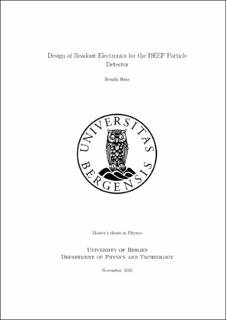| dc.contributor.author | Husa, Bendik | |
| dc.date.accessioned | 2021-12-21T00:47:06Z | |
| dc.date.available | 2021-12-21T00:47:06Z | |
| dc.date.issued | 2021-11-22 | |
| dc.date.submitted | 2021-12-20T23:00:03Z | |
| dc.identifier.uri | https://hdl.handle.net/11250/2835156 | |
| dc.description.abstract | Along with electromagnetic radiation, the Sun also emits a constant stream of charged particles in the form of solar wind. When these particles enter Earth’s atmosphere through a process known as particle precipitation, they can through a series of chemical reactions produce N Ox and HOx gases. These gases are greenhouse gases and deplete the ozone in the mesosphere and upper stratosphere. It is important to quantify the rate of production of these gases to model the potential climate impact. Existing particle detectors in space are suboptimal because they cannot determine the energy flux and pitch angle distribution of precipitating particles. The primary scientific objective of the DEEP project is to design a particle detector instrument that is specifically designed for particle precipitation measurements. This thesis investigates different data acquisition schemes for handling the signal from a pixel detector. The chosen approach is measuring the width of a shaped pulse to quantify the energy of the particle. Known as Time-over-Threshold, a detector circuit board is designed featuring high-speed comparators as threshold discriminators and the NG-MEDIUM FPGA from NanoXplore to implement the data acquisition. Digitizing the comparator pulse width is done with a Time-to-Digital converter (TDC) implemented in the FPGA fabric. Since the difference in pulse width is small for different energies, a high conversion resolution is required. Two high-resolution TDCs are designed and compared, both of which feature a digital counter and a method of interpolating the counter clock period. The first interpolation method applies the use of a multitapped delay line implemented with hard carry chain resources, and the second method oversamples the input with several equally off-phase sampling clocks. A resolution of 302 ps and a differential non-linearity of 3.26 was achieved with the delay line TDC clocked at 100 MHz. An automatic statistical calibration scheme is included to determine the actual delays of the delay line, utilizing a second asynchronous clock to generate uniformly distributed hits. The asynchronous oversampler resolution is clock frequency dependent and provides a 4-fold improvement to the clock period. The differential nonlinearity approaches zero with close matching of the off-phase clocks and operating frequency. A complete firmware design for the data acquisition and rocket telemetry of the detector is proposed and demonstrated. A simulation of the firmware utilizing each TDC topology is conducted and the delay line TDC is demonstrated to be the most accurate at all operating frequencies and thus the recommended TDC for the DEEP data acquisition. | |
| dc.language.iso | eng | |
| dc.publisher | The University of Bergen | |
| dc.rights | Copyright the Author. All rights reserved | |
| dc.subject | particle precipitation | |
| dc.subject | pixel detector | |
| dc.subject | particle detector | |
| dc.subject | TDC | |
| dc.subject | time-over-threshold | |
| dc.subject | data acquisition | |
| dc.subject | readout | |
| dc.subject | electron precipitation | |
| dc.subject | DEEP | |
| dc.subject | ToT | |
| dc.subject | time-to-digital converter | |
| dc.title | Design of Readout Electronics for the DEEP Particle Detector | |
| dc.type | Master thesis | |
| dc.date.updated | 2021-12-20T23:00:03Z | |
| dc.rights.holder | Copyright the Author. All rights reserved | |
| dc.description.degree | Masteroppgave i fysikk | |
| dc.description.localcode | PHYS399 | |
| dc.description.localcode | MAMN-PHYS | |
| dc.subject.nus | 752199 | |
| fs.subjectcode | PHYS399 | |
| fs.unitcode | 12-24-0 | |
